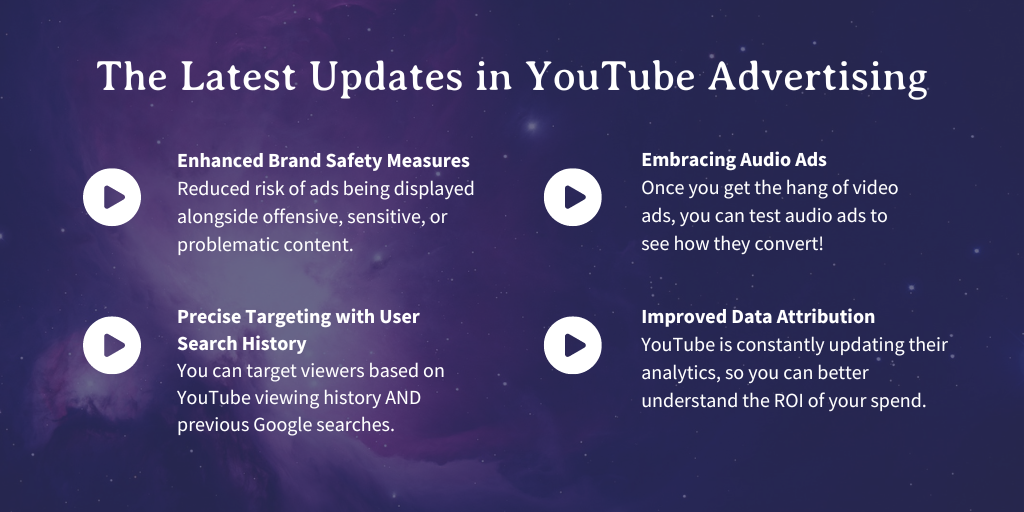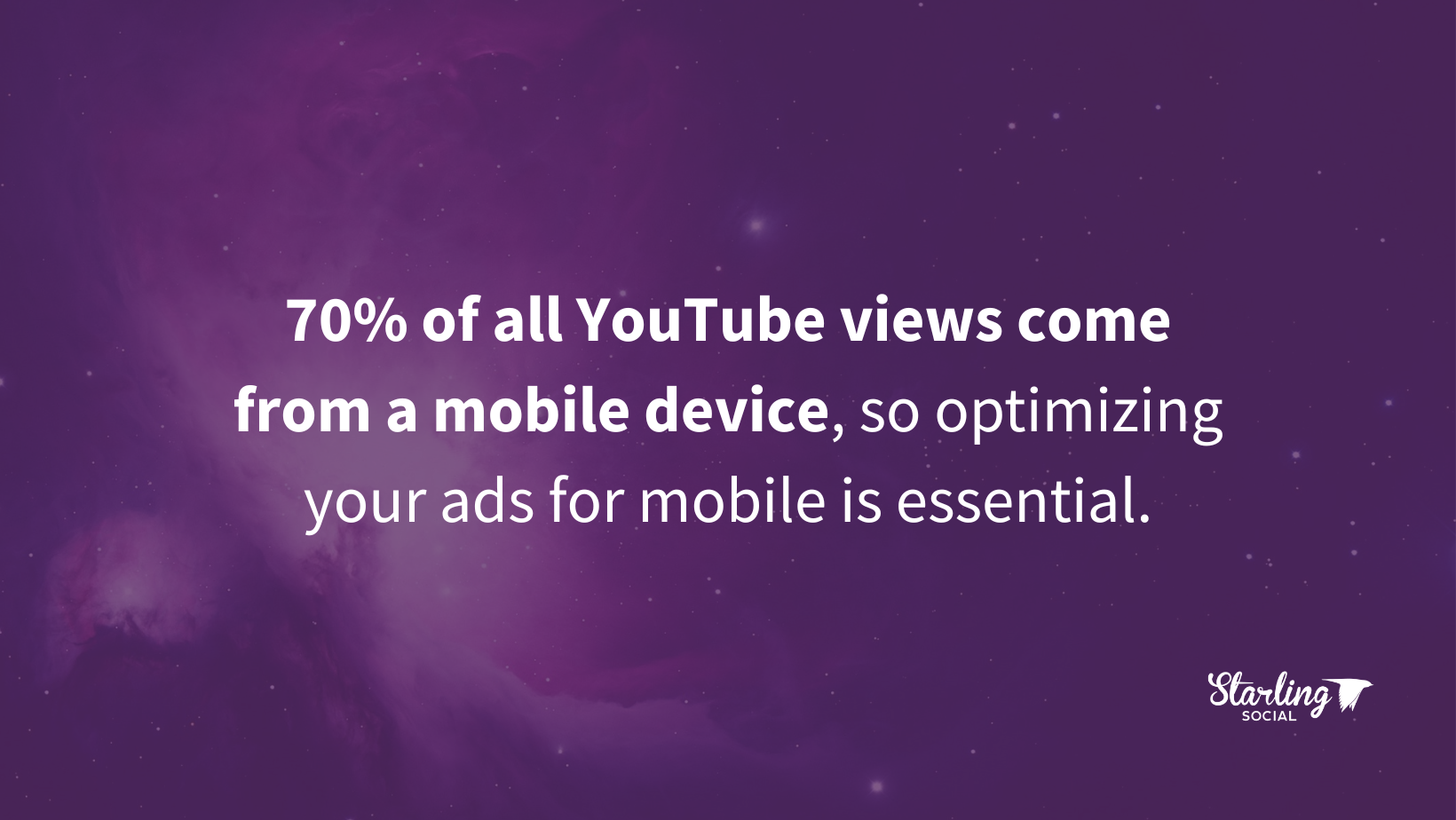10 Tips to Make the Most Out of Your YouTube Advertising Strategy
YouTube: the platform that probably needs no introduction. As the world's biggest video platform with billions of users worldwide, YouTube offers a vibrant community where content creators and businesses can connect, express themselves, and engage with audiences on a global scale.
With a user-friendly interface, personalized recommendations, and interactive features, YouTube has carved out an important place as part of our modern digital culture.
Content on the platform shapes our culture, starts trends, discussions, and offers up a space for people to express themselves and connect at a global scale.
What is YouTube Advertising and Why is it Important?
From a business perspective, you might be wondering: what does YouTube offer me?
While there are lots of ways to leverage YouTube videos as part of your content strategy (more on that in a future post) one of the best ways for brands to use the platform is through YouTube Advertising.
What is YouTube Advertising?
YouTube Advertising allows advertisers to create customized ads that can be seen by millions of people around the world.
With YouTube Ads, you can target specific audiences based on their demographics, interests, and other factors. There are also several options available (which we go into below) so you can experiment with different kinds of ads to see what works best.
But before we go into how to create engaging YouTube video ads, let’s dig into some recent updates to the platform’s advertising features:
The Latest Updates in YouTube Advertising
Advertising on YouTube is a totally different landscape than social media or pay-per-click (PPC) ads. These ads have unique constraints and a variety of options that aren’t available on other platforms, so it’s important to have at least a basic understanding of how the platform works.
With this in mind, let’s take a look at the latest changes Google (who own YouTube) have introduced:
Enhanced Brand Safety Measures
One of the biggest risks to advertising is the risk of having your ad shown next to offensive, sensitive, or problematic content, but YouTube’s been hard at work to make sure this doesn’t happen.
As of November 2022 the platform has introduced "clearer language" and "specific guidelines" to ensure ads aren’t placed on adult content, violent or dangerous acts, sensitive events, videos with inappropriate language, and drug-related content.
Precise Targeting with User Search History
The platform allows advertisers to target viewers based not just on their YouTube viewing behaviours, but also on their Google search history. This means you can now target ads at people who have recently searched for a specific product or service.
By aligning the content of your video ad with a viewer's recent searches, you can increase the likelihood of them watching the entire ad or clicking through to your website.
Embracing Audio Ads
Podcasts are some of the most hotly-consumed content online (41% of people in the US tune into a podcast every month, alone) and as a result audio-only content has become increasingly more popular.
As a result, Google has introduced audio-only ads for YouTube.
While starting with video ads is recommended, audio ads can be a useful addition to your ad library once you've developed your brand voice and have the data to know what kind of messaging resonates most with your audience.
Improved Data Attribution Models
If you know us you know we love data, which is why we love how much Google has improved its ability to measure user engagement with YouTube ads.
Using the analytics dashboard, you can learn about important details like your cost-per-conversion and gain insights into the performance of your YouTube ads alongside your Search and Shopping ads' reports.
YouTube Advertising Cost and Value
YouTube ad costs are based on views, with each view typically ranging between $0.05 and $0.10, depending on your industry and target keywords.
Compared to traditional Google Search, where the average cost per click is estimated to be between $1 - $2 per click depending on your industry, YouTube offers a cost-effective way to target your audience with engaging video or audio content.

10 Ways to Make the Most Out of Your YouTube Ads
1. Define Clear Objectives
Before jumping into YouTube advertising feet-first you need to to establish clear objectives.
Ask yourself: What do you want to achieve?
Take the time to decide what a “successful” campaign looks like. Whether it's increasing brand awareness, driving website traffic, generating leads, or boosting conversions, having a well-defined goal will guide your strategy and help you measure your campaign's effectiveness.
2. Develop an Effective Targeting Strategy
You need to show your ads to the right people in order for them to be effective.
This is known as “ad targeting” and should always be the first step in developing any kind of ad campaign. Here’s how to get started:
Know Your Target Audience
You need to know your target audience inside and out in order to create engaging and relevant ad content. This means doing research into their preferences, interests, and demographics before you even consider creating any ads.
Identifying details like their age, gender, location, and other relevant factors allows you to tailor your content to speak to them and resonate with their needs.
If you already publish content to your own YouTube channel, you can use YouTube Analytics to tap into that treasure trove of data and learn things like your audience’s viewing habits, engagement levels, and the demographics of who watch your videos.
Targeting the Right Users
YouTube offers a variety of targeting options to help you narrow down and reach the specific audience you want to engage with. Make sure to include relevant keywords and optimize your video titles, descriptions, and tags to increase visibility and attract the right users.
Collaborating with influencers or partnering with channels that share a similar target audience (more on this below!) can also be an effective way to reach a broader set of potential viewers.
Understanding YouTube's User Demographics
YouTube has a diverse user base, and understanding its demographics will go a long way to executing a successful YouTube Ads strategy.
Review the demographics of the platform like age groups, gender distribution, and geographical locations of users to tailor your content accordingly.
For example, if your target audience is largely young adults, create content that aligns with their interests and jumping on trending content and themes can help your ads stand out.
2. Choose the Right Types of Ads
YouTube offers several types of ad formats, meaning that you can strategically promote your content, products, or services to your target audience.
Take a look at this list and ask: which of these options would work best for my brand?
TrueView Ads
TrueView ads are a flexible and user-friendly advertising option. With TrueView in-stream ads, you can engage users before they watch the video they want to see.
You can show your ad at the start, or partway through the video. These ads give viewers the option to skip after a few seconds, meaning you only pay when users decide to watch the entire ad.
TrueView discovery ads appear as thumbnail images along with related videos or in YouTube search results, which encourages viewers to click and explore your content further.
Bumper Ads
Bumper ads are short, non-skippable video ads that last up to six seconds.
These ads are a great way to deliver a tight, targeted message to viewers and make a lasting impression.
Bumper ads work best when you want to create brand awareness or share a quick teaser that encourages the viewer to learn more.
Display Ads
Display ads on YouTube are banners that show up on the right side of the video or above the video suggestions list and offer an opportunity to promote your brand, products, or services while viewers are browsing or watching videos.
These ads can be static images or animated GIFs, allowing you to grab viewers' attention and drive traffic to your website or landing page.
Overlay Ads
Overlay ads appear as transparent overlay banners at the bottom of a video and can be either text-based, or display images. They offer a non-intrusive way to deliver your message while keeping the focus on the video content.
These ads offer more information and are generally used to encourage viewers to take a specific action.
3. Craft Compelling Video Ads
Your video ads need to capture attention and tell a compelling story.
Start with a strong hook within the first few seconds to catch viewers’ attention and encourage them to keep watching.
Keep your message concise, focus on the benefits, and showcase what makes your product or service unique.
Don't forget to include a clear call-to-action that encourages viewers to take the next step that you want them to take!

4. Optimize for Mobile
70% of all YouTube views come from a mobile device, so optimizing your ads for mobile is essential.
Make sure your ads have eye-catching graphics, include clear easy to understand language, and engage viewers even on smaller screens.
We also recommend considering vertical video formats (which look best on mobile screens) and subtitles or captions can make your content even more accessible.
5. Leverage Targeting Options
Take advantage of demographic targeting, interests, and affinity audiences to deliver your ads to people who are most likely to be interested in what you offer.
You should also consider utilizing custom intent audiences, which allow you to target viewers based on their search history and recent online activities.
6. Test and Iterate
The honest truth about advertising (and a lot of marketing in general) is that it often takes testing and iterating on an idea to get it right - and YouTube ads are no exception.
Experiment with different ad formats, messaging, targeting options, and calls-to-action to learn what works best with your audience.
Make sure to analyze the performance of your campaigns and make data-driven optimizations to continually improve your results.
7. Monitor Your Ad Performance
We say this all the time but it bears repeating: don’t “set and forget” your ads!
Keep a close eye on your performance metrics to understand what's working and what needs to be adjusted.
Track key metrics on a per-ad basis like the view-through rate, click-through rate, engagement rate, and conversions.
8. Consider Remarketing
Remarketing allows you to re-engage with users who have already interacted with your brand or shown interest in your products or services.
By delivering personalized messaging to users who are already familiar with your brand, you can increase the likelihood of conversions and maximize your advertising efforts.
9. Collaborate with Influencers
Partnering with YouTube influencers can offer a big boost to your brand's visibility and credibility.
Identify influencers within your niche whose audience align with your target audience and work with them to create engaging, authentic content that introduces your products and services to a wider audience.
10. Measure ROI and Adjust Budget
This ties into our earlier point about monitoring your ads, but by continuously looking at the return on investment (ROI) of your YouTube Ads, you can quickly make adjustments to your budget based on how your campaigns are doing.
By staying engaged with your campaigns and taking an “agile” approach (vs. the “set it and forget it” approach we talked about above) you can get the best bang for your advertising buck.
Elevate Your YouTube Ads Today
As we’ve seen, YouTube advertising presents a powerful opportunity to connect with your audience, drive engagement, and achieve your marketing objectives.
By staying informed, creative, and adaptable, you can stay ahead of the curve and make the most of this powerful advertising platform. And hey - if all of this is sounding like a lot of work (and, trust us, it is) we’d be happy to help.

